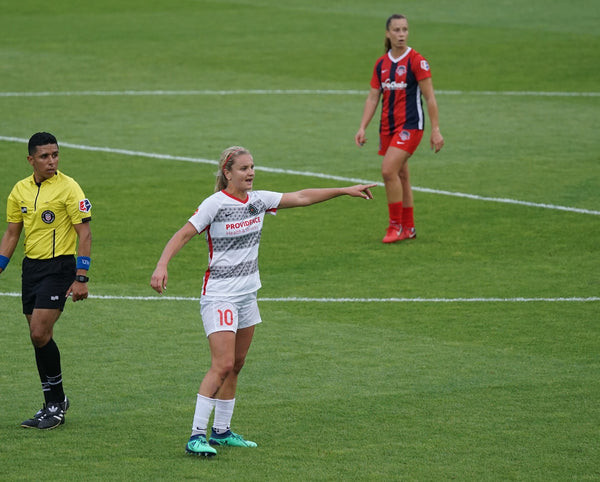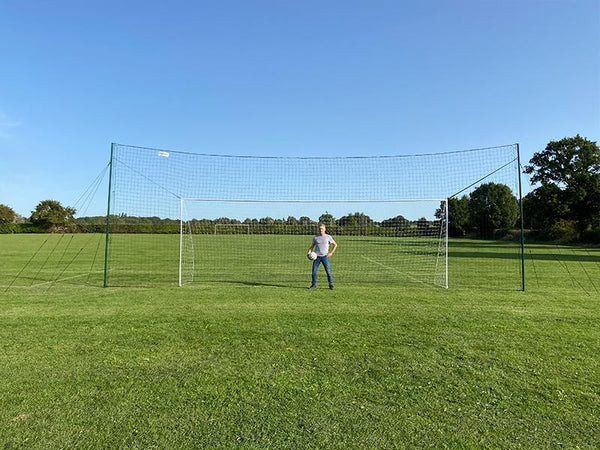Are you confused by the hand signals you see referees making during a football game? This comprehensive guide from CAUHOI2025.UK.COM breaks down all the referee signals in football, explaining their meanings and importance for players and fans alike. Learn about the different signals for fouls, penalties, and more, ensuring you never miss a call. Understand football referee signals, assistant referee signals, and video assistant referee signals for a better understanding of the game.
1. The Role of Referees in Football
In a football match, the referee plays a vital role in ensuring fair play and enforcing the rules of the game. According to the International Football Association Board (IFAB), the Laws of the Game outline the responsibilities of the referee, including monitoring play, stopping and restarting the game, and penalizing misconduct. Their decisions are final and should be respected by all players and team officials.
1.1. The On-Field Officials
There is one main referee on the field. The main referee is assisted by two assistant referees positioned along the sidelines. According to IFAB rules, there may also be:
- A fourth official
- Two additional assistant referees
- A reserve assistant referee
Each official has specific duties detailed by the IFAB. The referee can relieve them of their duties if they break the rules or interfere unduly.
1.2. The Video Assistant Referee (VAR)
The Video Assistant Referee (VAR) helps the referee to make decisions based on replay footage. The use of VAR and one or more assistant VARs (AVAR) has been permitted since the 2018/2019 edition of The Laws of the Game.
2. Decoding Football Referee Signals
Referees use a variety of hand signals, whistles, and body language to communicate their decisions during a match. These signals are essential for conveying information to players, coaches, and spectators. Here are some common referee signals:
2.1. Signals for Restarting Play
- Goal Kick: The referee points toward the goal area of the defending team.
- Corner Kick: The referee points to the corner arc or corner flag.
- Throw-in: The referee points in the direction of the throw.
- Kickoff: Signaled by the whistle at the start of a match or after each half.
2.2. Signals for Fouls and Misconduct
- Direct Free Kick: The referee holds up one hand and points toward the defending goal.
- Indirect Free Kick: The referee raises one hand vertically in the air until the kick is taken.
- Penalty Kick: The referee points to the penalty mark.
- Red Card and Yellow Card: The referee displays the card with one hand raised above the head.
2.3. Signals for Gameplay Management
- Play On/Advantage: The referee runs forward while holding out both hands horizontally with palms facing up, signaling to continue playing.
- Check: The referee puts one finger to the ear and extends one arm horizontally while checking a decision with other on-field officials.
- Review: The referee makes a TV signal with the hands to activate the video assistant referee.
- Handball: The referee touches one hand to indicate a handball offense.
3. Assistant Referee Signals Explained
Assistant referees (ARs) play a critical role in assisting the main referee. They primarily use a flag to signal various events and communicate with the referee. Here’s a breakdown of the most common assistant referee signals:
3.1. Offside Signals
The assistant referee signals an offside offense by raising the flag above their head. The angle of the flag indicates the player’s position:
- Middle: The flag is held horizontally for an offside in the middle of the field.
- Near Side: The flag is held up at a 45-degree angle for an offside on the near side.
- Far Side: The flag is held down at a 45-degree angle for an offside on the far side.
3.2. Signals for Fouls and Misconduct
The AR raises the flag to attract the referee’s attention when a foul occurs outside the referee’s line of sight.
3.3. Signals for Restarting Play
- Goal Kick: The flag is held out horizontally when the ball crosses the goal line.
- Corner Kick: The flag is pointed downward at a 45-degree angle toward the corner flag.
- Throw-in: The flag is held out to one side at a 45-degree angle, indicating the direction of the throw.
3.4. Other Signals
- Player Substitution: The AR raises both hands and the flag during the next stoppage of play.
- Goal: The flag is lowered, and the assistant referee moves back toward the halfway line. If they want to dispute the goal, they stay in position with the flag held up.
4. The History and Evolution of Referee Signals
The use of hand signals in football refereeing is credited to Dr. Ellwood A. Geiges, a referee in the early 20th century. He created the signals to better inform the press about the referee’s decisions during the match. While none of the original signals from the 1920s are still in use, the concept has evolved to implement the modern laws of the game.
 Referee signaling a foul
Referee signaling a foul
5. The Significance of Whistle Signals
In addition to hand signals, referees also use whistles to control the flow of the game. The whistle is primarily used to start and stop play. FIFA rules state that the whistle should not be used too frequently, as it would lessen its impact. If the whistle is blown in error, a dropped ball restarts the play.
5.1. Types of Whistle Signals
The tone of the whistle can also convey the nature of the infraction. For instance, a short whistle might indicate a minor foul resulting in a free kick, while a long whistle can signal a more serious offense or a foul in the penalty area, leading to a penalty kick.
6. Referee Communication Technology
Modern football refereeing relies on more than just hand signals and whistles. Referees now have access to advanced communication technology, including:
- Electronic Communication Systems: Assistant referees can use electronic communication systems to communicate with the referee.
- Video Assistant Referee (VAR): VAR uses video replays to help referees make critical decisions, particularly those involving goals, penalties, red cards, and mistaken identity.
- Goal-Line Technology: This technology instantly alerts the referee when the ball has completely crossed the goal line, eliminating disputes over whether a goal has been scored.
7. How to Improve Your Understanding of Referee Signals
To enhance your comprehension of referee signals, consider the following tips:
- Watch More Games: Pay close attention to the referee’s signals during live or recorded matches.
- Study the Laws of the Game: Familiarize yourself with the official rules and regulations of football, available on the IFAB website.
- Practice with Friends: Simulate game situations and practice using the correct signals with friends.
- Attend Refereeing Courses: Consider taking a refereeing course to gain a deeper understanding of the game’s rules and officiating procedures.
- Consult Resources: Utilize online resources like CAUHOI2025.UK.COM to learn more about specific signals and scenarios.
8. Common Misconceptions About Referee Signals
- All whistle signals are the same: Different whistle tones can indicate the severity of the offense.
- Referee signals are only for players: Signals are also intended to inform coaches, spectators, and other officials.
- Hand signals are universal: While most signals are standardized, some variations may exist based on local guidelines.
- The referee is always right: While the referee’s decisions are final, they can be reviewed and corrected by the VAR in certain situations.
9. The Impact of Referee Decisions on the Game
Referee decisions can significantly impact the outcome of a football match. Fair and accurate officiating ensures that the game is played according to the rules, maintaining its integrity. Key decisions, such as penalty calls, red cards, and offside rulings, can change the momentum of a game and influence the final result. The use of VAR aims to minimize errors and ensure that critical decisions are made correctly. According to a study by the University of Pennsylvania, the introduction of VAR has led to a decrease in incorrect penalty decisions by 15%.
10. The Future of Refereeing
The role of the referee is constantly evolving with advancements in technology. Future trends in refereeing may include:
- Improved Communication Systems: Enhanced communication between referees and assistant referees through wearable technology.
- Artificial Intelligence (AI): AI-powered systems to assist referees in making offside decisions and identifying fouls. According to a report by KPMG, AI could reduce human error in refereeing decisions by up to 30%.
- Real-Time Data Analytics: Use of real-time data analytics to provide referees with additional information and insights during the game.
11. FAQs
11.1. What is the referee signal for a five-second violation?
The rules of football don’t mention any five-second violation. However, an indirect free kick can be awarded if the goalkeeper holds on to the ball inside the penalty area for more than six seconds.
11.2. What is the offsides signal in football?
The assistant referee announces an offside offense by raising the flag. The referee then awards an indirect free kick to the defending team.
11.3. What signals does a football referee use for substitution?
The AR holds both hands up along with the flag as the sign for a substitution. The referee then initiates the process during a stoppage.
11.4. What do two whistles mean in football?
Two long and hard blasts of the whistle indicate a serious offense that is punishable by the display of cards.
12. Final Thoughts
Understanding football referee signals is crucial for players, coaches, and fans to fully appreciate the game. These signals ensure that everyone is on the same page, promoting fair play and maintaining the integrity of the sport. By familiarizing yourself with these signals, you’ll enhance your overall football experience and gain a deeper understanding of the beautiful game.
 Youth football practice
Youth football practice
For young players looking to hone their skills, consider the Open Goaaal Football Rebounder. It’s a safe and effective way to practice football in your backyard, helping you improve your game without chasing down balls.
If you’re looking for more information and reliable answers to your burning questions, CAUHOI2025.UK.COM is here to help. Visit our website today to explore a wealth of information on various topics, or contact us at Equitable Life Building, 120 Broadway, New York, NY 10004, USA or call +1 (800) 555-0199 for personalized assistance. Whether you’re a student, professional, or retiree, CAUHOI2025.UK.COM is your trusted source for clear, concise, and credible information.
Take action now:
- Visit CauHoi2025.UK.COM for more insightful articles and answers.
- Explore our contact page for personalized support and guidance.
- Share this article with friends and family to help them better understand football referee signals.
This guide will help you understand football, referee signals, assistant referee signals, VAR signals, and officiating procedures.
